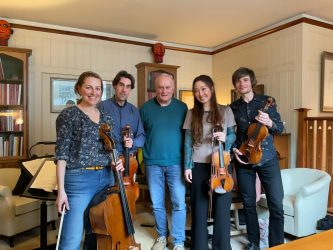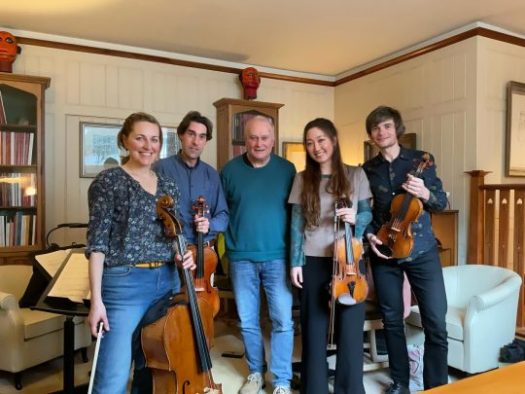 United Kingdom Mozart, Britten: Sacconi Quartet (Ben Hancox, Haim Choi [violins], Robin Ashwell [viola], Cara Berridge [cello]). Wigmore Hall, London, 31.3.2024. (CC)
United Kingdom Mozart, Britten: Sacconi Quartet (Ben Hancox, Haim Choi [violins], Robin Ashwell [viola], Cara Berridge [cello]). Wigmore Hall, London, 31.3.2024. (CC)

Mozart – String Quartet in B-flat, K 589, ‘Prussian’ (1790)
Britten – String Quartet No.3, Op.94 (1975)
The Sacconi Quartet boasts an extensive discography, from Haydn and Beethoven through to Graham Fitkin and John McCabe. No Mozart, though, as yet; but it was with Mozart this concert began, the exquisite late B-flat Quartet, K 589.
The Sacconi Quartet’s regular second violinist is listed on their website as Hannah Dawson; the Sacconi Quartet is listed as a mentor of German-born South Korean violinist Haim Choi, who took the second violin spot instead of Dawson – who is on maternity leave – with great success. Choi is also a member of the Salomé Quartet.
The first movement of K 589 is one of the ideal examples of conversation within a string quartet: dialogues between instruments, and groupings of instruments abound; hence, perhaps, the link to Britten’s Third Quartet (whose first movement, ‘Duets’ is all about such combinations). That grouping idea is there right at the beginning of Mozart’s masterpiece, with the viola as a sort of pivot (violins and viola against viola and cello); the young Sacconi Quartet played it with all the maturity of an elder statesperson ensemble.
Famously, the so-called ‘Prussian’ Quartets foreground the cello at various points (King Friedrich Wilhelm II of Prussia, for whom these quartets were written, was an amateur cellist). As music, Mozart’s K 589 is perfection itself; something that one certainly felt in this lovely performance. There were many notable individual contributions: Cara Berridge’s high-lying lines in the second movement Larghetto, some truly beautiful phrasing from violist Robin Ashwell and a second violin part full of life from Choi. Maybe only occasionally Ben Hancox’s first violin seemed not quite as solid as his colleagues’ efforts; not quite of the same confidence level, and his tone could sometimes err towards the harsh. Nevertheless, the finale was a moment of equals, inner lines superb, contrasts finely calibrated.
Britten’s Third Quartet is a remarkable piece. Dating from 1975, this was the composer’s last major work. There are five movements, four of which were written in Suffolk, the final one at Hotel Danieli in Venice. It is dedicated to the great musicologist Hans Keller and was premiered by the Amadeus Quartet at Snape Maltings in December 1976 (some two weeks after the composer’s death).
Formally, there are a lot of arches here. Each movement is in ternary form (ABA); the quartet as a whole has a slow movement (‘Solo’) at its centre, surrounded by two fast movements (‘Ostinato’ and ‘Burlesque’), that are balanced by two outer slow movements (‘Duets’ and ‘Recitative and Passacaglia (La Serenissima)’. ‘La Serenissima’ refers to Venice.
The challenges of the first movement are many, but possibly maintaining a pianissimo is the hardest, and something the Sacconi fully achieved. Britten’s machinations were mesmeric; harmonics, too, glowed. Formally, the movement was perfectly honoured, the climax perfectly approached, the calm after the storm similarly effective.
There are no missing nods to Shostakovich at the opening of the second movement, ‘Ostinato’; the Sacconi performance was absolutely resolute here, the continuation relentlessly determined. There is an appealing rigour to Britten’s writing that came through strongly. Individual delights abounded: a second violin melody against pizzicato cello, luminous chords elsewhere like light through a stained-glass window. Britten plays with registral gaps in the third movement (‘Solo’) the high first violin against chthonic cello (easing its way slowly upwards, aspirationally). A special mention for the control of violist Robin Ashwell in this movement, his contributions notably excellent. The fourth movement ’Burlesque’ brought back shadows of Shostakovich, soon interiorised into Britten’s world. The Sacconi was notably robust in their entries. This is a ‘danse macabre’, and certainly felt it. Finally, ‘Recitative and Passacaglia’ – that Passacaglia holds no fewer than five references to Britten’s last opera Death in Venice (1973). The finale contains Britten’s most advanced writing of the work, also: textures are thinned to a minimum, a cello tread seems to imply the inevitability of death itself. It is a remarkable piece, and this performance was itself remarkable.
Britten’s Third Quartet seems to bring out the best in its performers: the last time I heard this work at Wigmore Hall was with the Brentano String Quartet in 2016, another excellent account as I recall. (As far as Britten’s Third Quartet is concerned, a talk given by Professor Roger Parker on this piece, followed by a complete performance by the Badka String Quartet – available on YouTube – is absolutely recommended listening.)
There was an inevitable encore: two to be accurate, delightful arrangements by John Bowden of Old Molly Oxford and Christchurch Bells introduced by Ben Hancox, appositely, as ‘and now for something completely different’.
Colin Clarke
